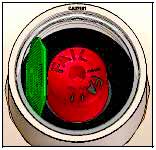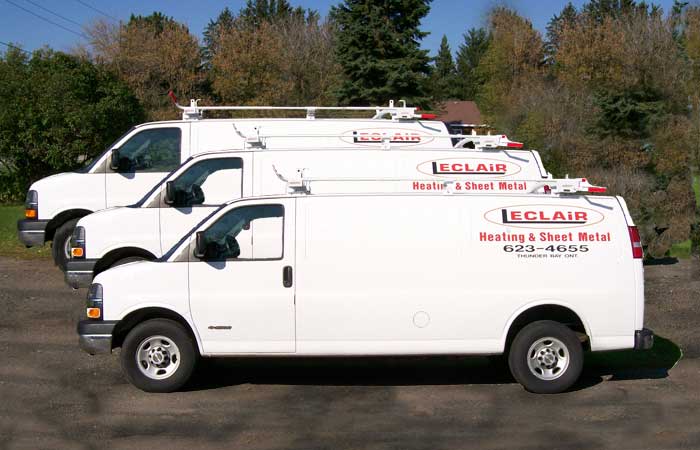

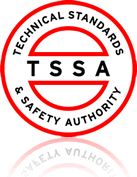

Authorized TRANE Dealer
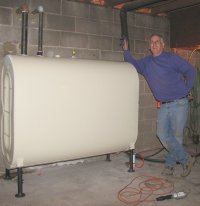
Des Leclair finishes installing a
Double-Bottom Oil Tank

Leclair Heating & Sheet Metal.
All rights reserved.
2613 McGregor Pl. Thunder Bay, Ontario P7E 5G9
Phone: (807) 623-4655
Home Heating Oil Tanks
Background
Nearly 40 percent of all oil spills reported to the Department of Environment annually are from domestic oil tanks at private homes.
A leaking oil tank can become a serious fire and environmental hazard. Whether the tank is located inside or outside the home, a spill can contaminate groundwater affecting a private well or other nearby drinking water supplies.
The removal of oil from a basement, or the cleanup of contaminated soil and water can be difficult and very costly.
As a tank owner, the homeowner is responsible to protect their property and the environment by having a properly installed and well maintained home heating oil tank.
Heating Oil Tank System Checkup
There are several factors that may affect the lifespan of your domestic heating oil storage system. They include, but are not limited to, the tank's type, age, location, outlet type, support base, line protection, and maintenance.
This following questionnaire will help you, the homeowner, to identify any potential problems with your oil storage system and determine your comfort level with the risks associated with them. Note that this assessment of potential risks does not guarantee that an incident will not occur in the future. It is merely a self-evaluation guide to assist you in your decision-making process.
Questions indicated with an asterisk (*) apply only to unprotected tanks (i.e., tanks not constructed or lined with non-corrosive materials).
Homeowner's 21-Point Oil Tank System Checkup
- Does the tank have a tag or label showing it has been
constructed to meet national standards?

- Is the tank free from visual signs of damage?

- Do the vent and fill pipes exit your home in the case of an
inside installation?

- Is the fuel filter inside the building?

- Is the tank fully above ground (no partially buried
components)?

- Has fuel been transferred from an old tank to a new tank?*
 If you answered "No" to any of the first five questions and/or "Yes"
to question six, the department considers your system to be at a
higher risk and recommends that you have a heating service
professional check your oil tank as soon as possible.
If you answered "No" to any of the first five questions and/or "Yes"
to question six, the department considers your system to be at a
higher risk and recommends that you have a heating service
professional check your oil tank as soon as possible. - Is the tank shell thickness greater than 14 gauge steel?*

- Is the tank less than 15 years old?*

- Does the tank have a bottom feed outlet?*

- Is the tank installed inside?

- Has the tank been installed vertically?

- Does the oil line run on top of the basement floor?

- Does the tank have a vent whistle or alarm?

- Is the tank equipped with an outlet valve/line protector?

- Is the tank equipped with an oil-level gauge protector?

- Is the tank equipped with an anchoring device?

- Is the tank painted with a corrosion resistant coating?*

- Does the tank have an internal corrosion resistant coating?*

- Do you routinely remove any water/sludge buildup in the
tank?*

- Is the system equipped with secondary containment or leak
detection devices?

- Do you have a system inspection and cleaning annually by a heating service professional?

As a general rule, each "No" you answered to these questions (and/or "Yes" to question six) increases the risk associated with your oil heating system. This assessment, coupled with the information throughout the guide, should provide you with a good basis for determining your comfort level with any potential problems associated with your oil tank system. If your evaluation raises your level of concern over some aspect of your system, the department recommends that you have a heating service professional conduct a more detailed examination.
New Oil Tanks
Double Bottom Oil Tanks offer environmental protection.
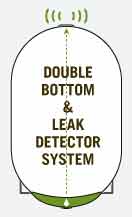
With the reduction of sulphur content in heating oil, tanks are more prone to corrosion. A small pin hole could spill 1000 Litres overnight. The positioning of a containment tray or dyke under and around the tank can help to collect the leaking product, and may prevent the discharge of the product to the environment. However, if the dyke or tray is not kept free of rain, snow or other obstructions it will not have the capacity to contain the oil product when the leak occurs.
Most corrosion occurs on the inside bottom of the tank where condensation and sludge would collect. New tanks are designed with a built in containment dyke – a double bottom. A highly visible leak detector warns the homeowner when a leak occurs.
Double Walled Oil Tanks

Another popular choice is the Double-walled tank. Designed to contain the entire contents of the tank within it's galvanized steel outer shell in case of a leak, the inner tank can be made plastic, reducing the overall weight of the tank, and overcoming many of the problems caused by corrosion.
When installed outside, most double-walled tanks require a Galvanized Cover be installed as part of the tank warranty.
Oil Tank Maintenance
It is important for the homeowner to understand that the oil tank is their property and their responsibility. The tank owner should ensure that it is properly maintained. Proper tank maintenance should include, but is not limited to, the following:
- Subscribing to an annual maintenance program performed by Leclair Heating, a licensed heating oil system service company;
- Visually inspecting the tank(s) at least once a year. Careful visual inspection will uncover traces of oil on the tank surface;
- Asking a service technician to check, at least once a year, for the presence of water inside the tank and to remove it.
- Correcting immediately a foundation if it is not stable or if the tank is likely to topple. The services of a licensed installer should be used.
- Maintaining at least once a year the outside surface of the tank by:
- Gently brushing the rusted areas on the outside of the tank with
sandpaper;
- Cleaning the surface;
- Applying a coat of rust proof metallic paint (readily available at any hardware store) to affected areas.
- Gently brushing the rusted areas on the outside of the tank with
sandpaper;
- Maintaining the tank liquid level as high as possible during the summer months to limit water condensation within the tank.
- Verifying the status of a double bottom tank at least once a year by
performing the following:
- When the tank is full, look into the monitoring opening on top
of the tank. If the red "FAIL" signal can be seen, it indicates a problem. Immediately Contact Leclair Heating for tank replacement.
